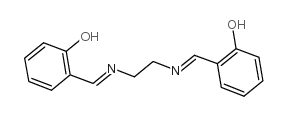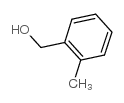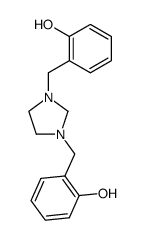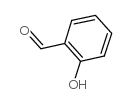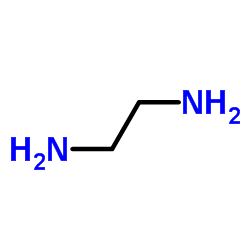18653-98-0
| Name | 2-[[2-[(2-hydroxyphenyl)methylamino]ethylamino]methyl]phenol |
|---|---|
| Synonyms | h4 salen |
| Density | 1.181g/cm3 |
|---|---|
| Boiling Point | 462.3ºC at 760 mmHg |
| Melting Point | 118-120ºC |
| Molecular Formula | C16H20N2O2 |
| Molecular Weight | 272.34200 |
| Flash Point | 153.9ºC |
| Exact Mass | 272.15200 |
| PSA | 64.52000 |
| LogP | 2.75900 |
| Vapour Pressure | 3.61E-09mmHg at 25°C |
| Index of Refraction | 1.615 |
|
Section 1: Product Identification Chemical Name:N,N'-Bis(2-hydroxybenzyl)ethylenediamine, min. 98% H4 SALEN CAS Registry Number:18653-98-0 Formula:C16H20N2O2 EINECS Number:none Chemical Family:organic amine Synonym:none
Section 2: Composition and Information on Ingredients IngredientCAS NumberPercentACGIH (TWA)OSHA (PEL) Title Compound18653-98-0100%no datano data Section 3: Hazards Identification Emergency Overview:No particular hazard associated with this material. Primary Routes of Exposure:Ingestion, inhalation Eye Contact:May cause slight to mild irritation of the eyes. Skin Contact:May cause slight to mild irritation of the skin. Inhalation:May be irritating to the nose, mucous membranes and respiratory tract. Ingestion:No specific information is available on the physiological effects of ingestion. Acute Health Affects:May be irritating to skin, eyes and respiratory tract. Chronic Health Affects:No information available on long-term chronic effects. NTP:No IARC:No OSHA:No SECTION 4: First Aid Measures Immediately flush the eyes with copious amounts of water for at least 10-15 minutes. A victim may need Eye Exposure: assistance in keeping their eye lids open. Get immediate medical attention. Wash the affected area with water. Remove contaminated clothes if necessary. Seek medical assistance if Skin Exposure: irritation persists. Remove the victim to fresh air. Closely monitor the victim for signs of respiratory problems, such as difficulty Inhalation: in breathing, coughing, wheezing, or pain. In such cases seek immediate medical assistance. Seek medical attention immediately. Keep the victim calm. Give the victim water (only if conscious). Induce Ingestion: vomiting only if directed by medical personnel. SECTION 5: Fire Fighting Measures Flash Point:no data Autoignition Temperature:none Explosion Limits:none Extinguishing Medium:carbon dioxide, dry powder or foam If this material is involved in a fire, fire fighters should be equipped with a NIOSH approved, positive pressure Special Fire Fighting Procedures: self contained breathing apparatus and full protective clothing. Hazardous Combustion andIf involved in a fire this material may emit toxic organic fumes. Decomposion Products: Unusual Fire or Explosion Hazards: No unusual fire or explosion hazards. SECTION 6: Accidental Release Measures Spill and Leak Procedures:Small spills can be mixed with vermiculite or sodium carbonate and swept up. SECTION 7: Handling and Storage Handling and Storage:Store in a tightly sealed container. Keep away from heat and direct sunlight. SECTION 8: Exposure Controls and Personal Protection Eye Protection:Always wear approved safety glasses when handling a chemical substance in the laboratory. Skin Protection:Wear protective clothing and gloves. Ventilation:Material may form a fine dust. If possible, handle the material in an efficient fume hood. If ventilation is not available a respirator should be worn. The use of respirators requires a Respirator Respirator: Protection Program to be in compliance with 29 CFR 1910.134. Ventilation:Material may form a fine dust. If possible, handle the material in an efficient fume hood. Additional Protection:No additional protection required. SECTION 9: Physical and Chemical Properties Color and Form:off-white xtl. Molecular Weight:272.35 Melting Point:118-120° Boiling Point:no data Vapor Pressure:no data Specific Gravity:no data Odor:none Solubility in Water:slightly soluble SECTION 10: Stability and Reactivity Stability:air and moisture stable solid Hazardous Polymerization:no hazardous polymerization Conditions to Avoid:none Incompatibility:Oxidizing agents Decomposition Products:carbon dioxide, carbon monoxide, nitrogen oxides, and organic fumes SECTION 11: Toxicological Information RTECS Data:No information available in the RTECS files. Carcinogenic Effects:No data available Mutagenic Effects:No data available Tetratogenic Effects:No data available SECTION 12: Ecological Information Ecological Information:No information available SECTION 13: Disposal Considerations Disposal:Dispose of according to local, state and federal regulations. SECTION 14: Transportation Shipping Name (CFR):Non-hazardous Hazard Class (CFR):NA Additional Hazard Class (CFR):NA Packaging Group (CFR):NA UN ID Number (CFR):NA Shipping Name (IATA):Non-hazardous Hazard Class (IATA):NA Additional Hazard Class (IATA):NA Packaging Group (IATA):NA UN ID Number (IATA):NA SECTION 15: Regulatory Information TSCA:Not listed in the TSCA inventory. SARA (Title 313):Not reportable under SARA Title 313 Second Ingredient:none SECTION 16 - ADDITIONAL INFORMATION N/A |
| Hazard Codes | Xi |
|---|---|
| Risk Phrases | 36/37/38 |
| Safety Phrases | 26-36/37/39 |
|
~99% 
18653-98-0 |
| Literature: Voronova, Krisztina; Purgel, Mihaly; Udvardy, Antal; Benyei, Attila C.; Katho, Agnes; Joo, Ferenc Organometallics, 2013 , vol. 32, # 15 p. 4391 - 4401 |
|
~% 
18653-98-0 |
| Literature: Sharma, Vibha; Khan European Journal of Medicinal Chemistry, 2001 , vol. 36, # 7-8 p. 651 - 658 |
|
~84% 
18653-98-0 |
| Literature: Rivera, Augusto; Quevedo, Rodolfo; Navarro, Miguel A.; Maldonado, Mauricio Synthetic Communications, 2004 , vol. 34, # 13 p. 2479 - 2485 |
|
~% 
18653-98-0 |
| Literature: Carril, Monica; Altmann, Philipp; Drees, Markus; Bonrath, Werner; Netscher, Thomas; Schuetz, Jan; Kuehn, Fritz E. Journal of Catalysis, 2011 , vol. 283, # 1 p. 55 - 67 |
|
~% 
18653-98-0 |
| Literature: Kalyanam, N; Parthasarathy, P C; Ananthan, L; Manjunatha, S G; Likhate, M A Indian Journal of Chemistry, Section B: Organic Chemistry Including Medicinal Chemistry, 1992 , vol. 31, # 4 p. 243 - 247 |
